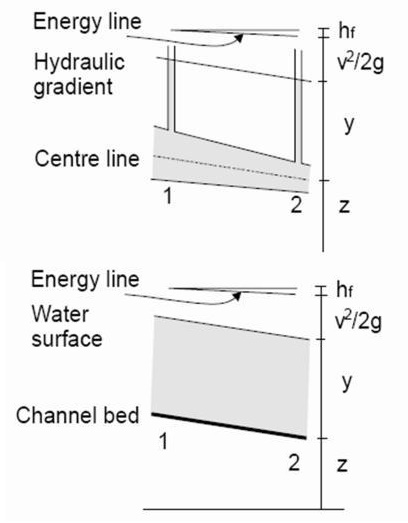Chapter: civil : Applied Hydraulic Engineering: Uniform Flow
Applied Hydraulic Engineering: Uniform Flow

Applied
Hydraulic Engineering: Uniform Flow
Introduction
Open-channel flow must have a free surface ,
whereas pipe flow has none. A free surface is subject to atmospheric pressure.
In Pipe flow there exist no direct atmospheric flow but hydraulic pressure
only.
The two kinds of flow are
compared in the figure above. On the left is pipe flow. Two piezometers are
placed in the pipe at sections 1 and 2. The water levels in the pipes are
maintained by the pressure in the pipe at elevations represented by the hydraulics
grade line or hydraulic gradient .
The pressure exerted by the water
in each section of the pipe is shown in the tube by the height y of a column of
water above the centre line of the pipe.
The total energy of the flow of the section (with reference to
a datum) is the sum of the elevation z of the pipe centre line, the piezometric
head y and the velocity head V /2g , where V is the mean velocity. The energy
is represented in the figure by what is known as the energy grade line or the
energy gradient .
The loss of energy that results when water flows from section
1 to section 2 is represented by hf.
A similar diagram for open
channel flow is shown to the right. This is simplified by assuming parallel
flow with a uniform velocity distribution and that the slope of the channel is
small. In this case the hydraulic gradient is the water surface as the depth of
water corresponds to the piezometric height.
Despite the similarity between the two kinds of flow, it is
much more difficult to solve
problems of flow in open channels
than in pipes. Flow conditions in open channels are complicated by the position
of the free surface which will change with time and space. And also by the fact
that depth of flow, the discharge, and the slopes of the channel bottom and of
the free surface are all inter dependent.
Physical conditions in
open-channels vary much more than in pipes - the
cross-section of pipes is usually round - but for
open channel it can be any shape.
Treatment of roughness also poses
a greater problem in open channels than in pipes. Although there may be a great
range of roughness in a pipe from polished metal to highly corroded iron, open
channels may be of polished metal to natural channels with long grass and
roughness that may also depend on depth of flow.
Open channel flows are found in
large and small scale. For example the flow depth can vary between a few cm in
water treatment plants and over 10m in large rivers. The mean velocity of flow
may range from less than 0.01 m/s in tranquil waters to above 50 m/s in
high-head spillways. The range of total discharges may extend from 0.001 l/s in
chemical plants to greater than 10000 m 3 /s in large rivers or spillways.
In each case the flow situation
is characterised by the fact that there is a free surface whose position is NOT
known beforehand - it is determined by applying
momentum and continuity principles.
Open channel flow is driven by
gravity rather than by pressure work as in pipes.
Related Topics